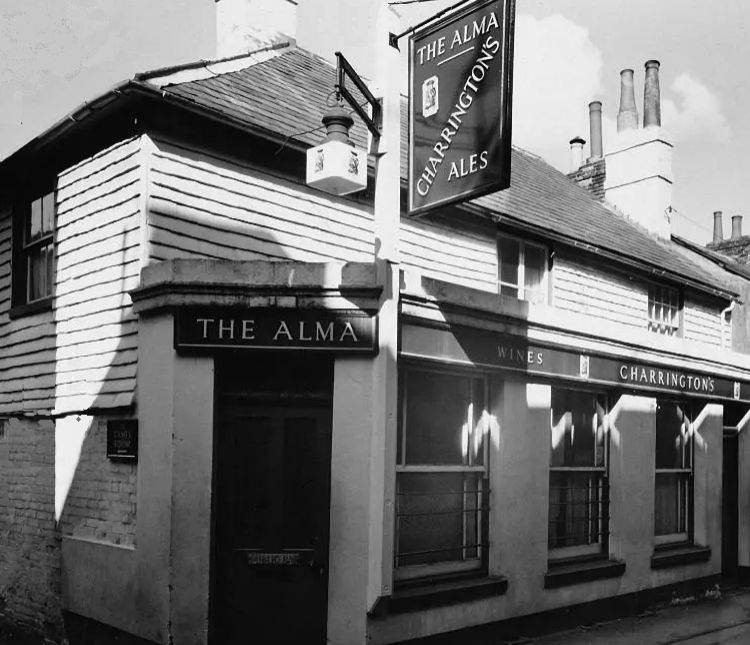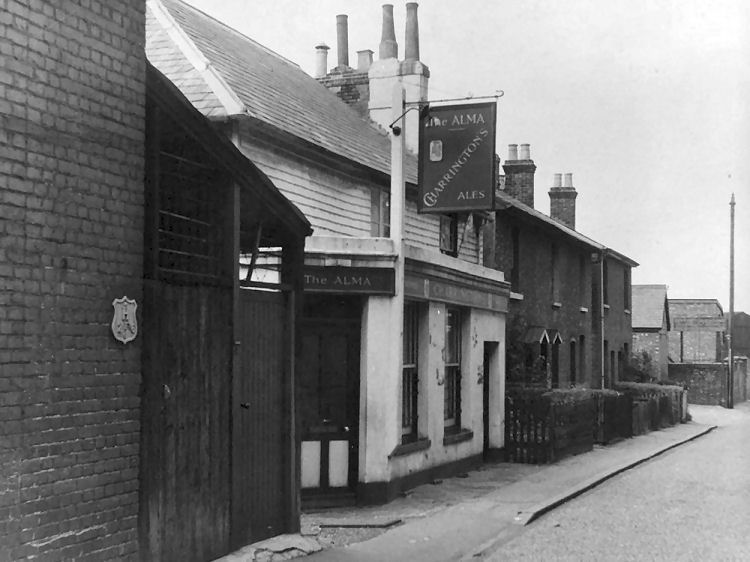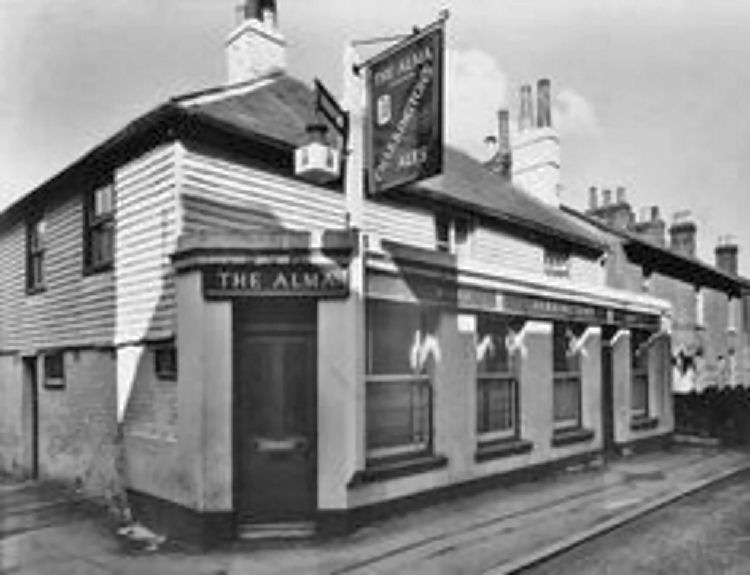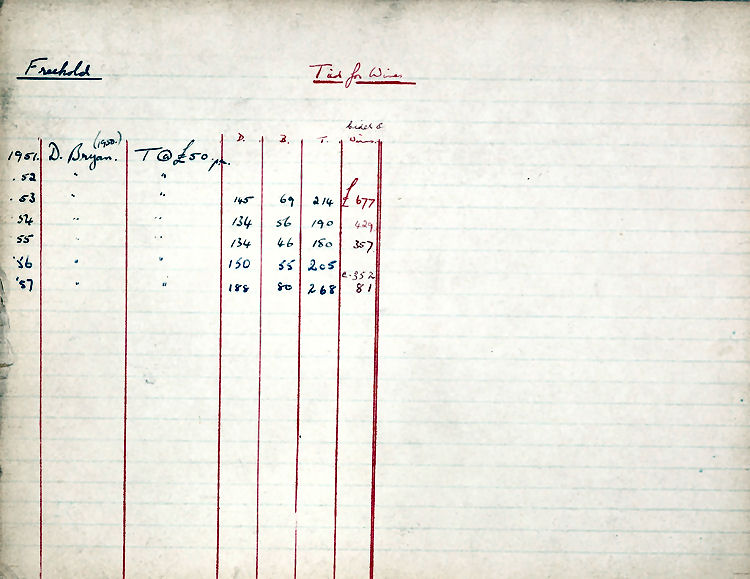|
Written By: Edward James Gilbert-Thunder Bay, Ontario, Canada Date: February 1, 2017.
THE ALMA TAVERN ON VARNEY STREET.
OVERVIEW.
The Alma Tavern, also known as the Alma Tavern Common Lodging House, was
located at 7 Varney Street. This ‘beer house’ was noted as being a rough
place in a part of town lived in by those from the lower end of the
social scale. It was just a stone’s throw away from another pub known as
the "Grosvenor Hotel" at 5 Ways and not far from a second pub called The
"Crown Tavern Common Lodging House" at 53 Varney Street. The
"Crown" and the
"Alma" and other buildings on the west side of Varney Street were
demolished after 1979 but before 1982 and the "Grosvenor," who’s front
façade only remains today, became the entrance to Royal Victoria Place
shopping centre. The land along Varney Street eventually was swallowed
up by the construction of the Royal Victoria Place shopping centre which
was opened by Princess Diana in 1992.
The name “Alma” came into common use throughout Britain to name pubs and
other buildings in recognition of the Battle of Alma during the Crimean
War. When this tavern began operations is a matter of some speculation.
Some have stated it started by 1871 but this is not supported by my
research for it does not appear in either the 1871 census or the 1874
Kelly directory. It first appears mentioned in the Kent & Sussex Courier
of June 23, 1875 and it may well have been run at that time by David
Brewer who was listed as beerhouse keeper there at the time of the 1881
census. There was in 1871 an "Alma Beer House" run by George Love, but
this pub was located at 4 North Street.
The "Alma" has been run by a number of beerhouse keepers since it began
operations and records of its existence can be traced up to 1979 when
Planning Authority approval was given for an illuminated sign for “The
Alma Public House 7 Varney Street”. This article reports on the location
and description of the tavern by text, maps and photographs and provides
information about the men and women who ran it. Shown above is the last
known photograph of the "Alma" dated 1959.
LOCATION AND DESCRIPTION
The "Alma Tavern" sometimes referred to as the "Alma Tavern Common Lodging
House," was located at 7 Varney Street, its location being shown and
labelled on the map below.
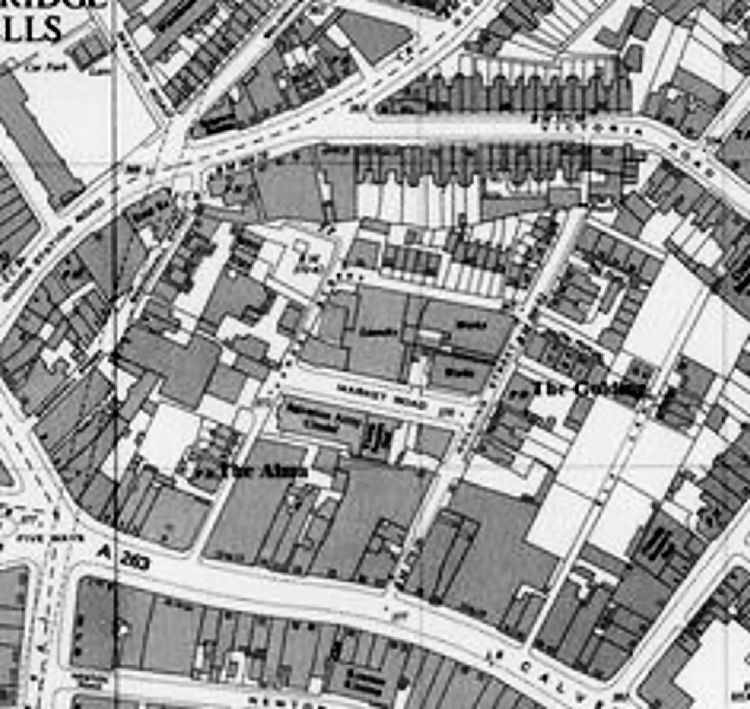
The Alma Tavern, like many other pubs and
buildings in England derive their name from The Battle of Alma of
September 20, 1854 during the Crimean War.
There was also another pub in Tunbridge Wells called the "Alma Beerhouse"
at 4 North Street, located south of Bayhall Road and east of Prospect
Road which in 1871 was run by beerhouse keeper George John Love. There
was also an "Alma House" in Tunbridge Wells, details of which were not
investigated except that the 1858 directory gave the listing “John
Arnold, builder, Alma House, Calverley Road”.
From the Inspiring Women website it was stated “Four of the common
lodging houses in Tunbridge Wells were also licensed premises. The "Crown"
and the "Alma" in Varney Street, the "Dorset Arms" in Calverley Street and
the "Standard" in Little Mount Sion. Three of them provided mixed
accommodation which meant shared washing facilities. Young unmarried
women were not admitted at all”.
Varney Street, Bassinghall Road, Goods Station Road and Golding Road
were among the streets in that part of town that were generally to be
avoided. Those that lived and worked there were from the lower end of
the social scale and police reports record them as having high crime
rates. The "Alma" and the "Crown" were noted for fights and disagreements
among their patrons and from a website about closed pubs it was stated
that the "Alma" was “a very basic beer pub, one up from spit and sawdust
in the 1960’s”. Just east of the "Alma" on the south east side of Varney
Street was the Salvation Army Citadel (now gone) who catered to saving
the souls of those who patronized the local pubs and consumed the demon
drink. No doubt some of them attended the regular Salvation Army
meetings, like the two young lads from the Baltic Sawmill (Goods Station
Road) Murder case that was widely reported on.
The Sussex Advertiser of November 16, 1878 reported on a crime that had
been committed at the "Alma Tavern" on Varney Street about the theft of an
umbrella, the property of Thomas Bachelor and involved a man who lived
at Yew Tree Farm in Southborough who was drinking with a friend of his
at the "Alma Tavern."
The Kent & Sussex Courier of January 18, 1900 gave a sad account when it
reported “Having conveyed to the mortuary the body of George Johnson,
aged 80, a pedlar, of no fixed address, who was found dead in a chair at
the "Alma Tavern," Varney Street where he was lodging. Dr. Elliott was
called but his services were of no avail”.
In terms of the building itself it was of modest red brick construction
and reported in the 1911 census to consist of 13 rooms at that time it
was occupied by Stephen Charles Skinner (given as Stenkin E Skinner in
the census) and fourteen lodgers. The sign on the pub in both images
above show that
Carrington’s Ales were served there. It is to be expected that over the
years, like most pubs in the town, the brewery that owned the pub had
changed and which breweries owned it in prior years was not determined
except that the Kent & Sussex Courier of June 23, 1875 carried an
advertisement by Kenward and Co, The Close Brewery who thanked those who
had patronized their pubs. The advertisement listed over six local pubs
owned by them including “The Alma Tavern, Varney Street”.
7 Varney Street was the site of the "Alma
Tavern" from 1875 up to circa 1979 when in or around that year it was
demolished along with all of the other buildings on the west side of
Varney Street. This fact can be seen from the 1982 map shown above from the Planning Authority files. The last and for that matter only
Planning Authority record for the "Alma" from 1975 onwards was in 1979
when in that year an application was approved for the installation of an
illuminated sign for “The Alma Public House, 7 Varney Street”. In the
years following developers put together a plan to redevelop the area and
in the late 1980’s and early 1990’s work began on designing and
constructing the Royal Victoria Place shopping centre, which swallowed
up the former site of the "Alma" and many other roads and buildings in the
area. This new mall was opened by Princess Diana in 1992.
[1] DAVID BREWER
Although David Brewer is not listed at the "Alma" in 1875 the Kent &
Sussex Courier noted the existence of the pub. David had been a resident
of Tunbridge Wells since 1868 and was the beerhouse keeper of the Alma
at the time of the 1881 census and so most likely was its first
occupant.
David Brewer was born 1841 in Hackney, London, one of five children born
to John Brewer, an agricultural labourer and later a shoemaker born 1814
in Mayfield, Sussex. David’s mother was Mary Ann Brewer born 1812 at
Mayfield, Sussex.
The 1841 census, taken at 3 Prospect Place in Hackney gave John Brewer
as an agricultural labourer. With him was his wife Mary Ann and this
sons James, born 1838 and David, born 1841.
The 1851 census, taken at Railway Cottage in Ticehurst, Sussex gave John
Brewer as a shoemaker. With him was his wife Mary Ann and five of their
children including their son James who was a railway labourer and David
who was attending school.
In 1866 David married Elizabeth Kneller in Tunbridge Wells. Elizabeth
had been born 1847 in Lewes, Sussex. David and his wife had eight
children between 1868 and 1890, all of whom had been born in Tunbridge
Wells.
The 1871 census, taken at 39 Stanley Road (image opposite), Tunbridge
Wells gave David as a plasterer. With him was his wife Elizabeth; two of
their children, and David’s sister Esther, age 27, a laundress.
The 1881 census, taken at the Alma Tavern, 7 Varney Street, Tunbridge
Wells gave David as a beerhouse keeper. With him was his wife Elizabeth;
five of their children and 10 lodgers.
The 1891 census, taken at 45 Stanley Road, Tunbridge Wells gave David as
a bricklayer. With him was his wife Elizabeth and six of their children,
all of whom except their son William, who was a groom stableman, were
attending school.
The 1901 census, taken at 20 Auckland Road gave David as a bricklayer
worker. With him was his wife Elizabeth and five of their children.
David Brewer passed away in Tunbridge Wells in the June 1905 and was
buried in the Tunbridge Wells Borough Cemetery on June 15th.
[2] EDWARD COLEMAN
Edward Coleman was listed at the Alma at the time of the 1891 census. He
was born 1859 at Sandhurst, Kent and was baptised May 22, 1859 at Sandhurst, one of several children born to Alfred and Elizabeth Hannah
Coleman.
The 1861 census, taken at Bayham Cottage in Frant, Sussex, gave Alfred
Coleman as an agricultural labourer born 1837 in Sandhurst, Kent. With
him was his wife Elizabeth Hannah, born 1838 at Ewhurst, Kent and their
son Edward, age 2.
The 1871 census, taken at Arphan Place in Tonbridge gave Alfred Coleman
as a labourer, With him was his wife Elizabeth; three of their children
including Edward, a scholar, and one boarder.
The 1881 census, taken at Budzell Park, Brenchley, Kent, gave Alfred
Coleman as a farm bailiff. With him was his wife Elizabeth; their son
Edward, a gardener; a niece and two farm workers.
In the 1st qtr of 1886 Edward married Emma Ashdown in Sevenoaks, Kent.
Emma had been born 1862 at Newbury, Kent but died sometime before 1901
but after the birth of a daughter Gladys in Tunbridge Wells in 1890.
The 1891 census, taken at The Alma Tavern, 7 Varney Street gave Edward
Coleman as a beerhouse keeper. With him was his wife Emma; their
daughter Gladys and two lodgers.
The 1901 census, taken at North Frith, Hadlow gave Edward Coleman as a
gardener domestic, With him was his second wife Annie, born 1862 at
Whitstable, Kent and Edwards daughter Gladys, age 6 mths, born 1890
Tunbridge Wells.
The 1911 census, taken at 100 Auckland Road listed Edward Coleman and
his family. Edward Coleman died in the 1st qtr of 1946 at Ashford, Kent.
Shown above is a photograph of Auckland Road dated 1905.
[3] WILLIAM CHAPLIN
The presence of William Chaplin at the Alma was recorded in the 1899
Kelly directory as “The Alma Tavern,7 Varney Street, William Chaplin
beerhouse keeper. Strangely no other definitive records for him were
found.
[4] STEPHEN CHARLES SKINNER
Stephen was born 1870 in Canterbury, Kent and baptised there on July
10, 1870. He was one of ten children born to John Skinner, a carter, born
1837 in Canterbury and Esther Skinner born 1842 in Canterbury.
In the period leading up to 1881 he lived with his parents and siblings
in Canterbury. The 1881 census, taken at 15 Duck Lane in Canterbury gave
John Skinner as a carter. With him was his wife Esther and nine of their
children, including Stephen who was attending school. Stephen’s brother
John was a general dealer and his brothers James, Alfred and Frederick
were all errand boys. The rest of the children were attending school.
The 1891 census, taken at 55 Sussex Street in Southwark, London gave
Stephen as a single man living on his own and working as a gas works
labourer.
In 1895 Stephen married Ada Parry (1876-1896) who appears to have died
while giving birth to their first child, for in July 1898 Stephen
married Kate Clara Brett (1874-1954) in Canterbury and with her had six
children between 1898 and 1913. From the children’s birth records it was
noted that their first child was born 1898 at Westerham, Kent; who was
followed by three children born in Tunbridge Wells in 1900, 1901 and
1908, and then the last two were born in Brighton, Sussex in 1912 and
1913.
The 1901 census, taken at The Alma, 7 Varney Street, gave Stephen as a
publican employing others. With him was his wife Kate, born 1874 in
Canterbury and their children Esther, age 2 and Jessie, age 1. Also
there were two servants and ten lodgers.
The 1911 census, taken at The Alma, 7 Varney Street, gave Stephen as
married but no members of his family were with him. He was given as a
beer retailer. With him in premises of 13 rooms were fourteen lodgers.
The census recorded that he had been married thirteen years and that he
had five children, all of whom were still living. In this census
Stephen’s name was incorrectly given as “ Stenkin E. Skinner”.
Stephen and his family left Tunbridge Wells after the 1911 census and
before 1912 when in that year his son Stephen Alfred Skinner was born in
Brighton.
Stephen Charles Skinner died March 1,1917 at Carlton Hill, Brighton,
Sussex. Probate records gave him of 97 Carlton Hill at the time of his
death. The executor of his 1,245 pound estate was his widow Kate and his
son Frederick Skinner (1907-1981) a licensed victualler.
[5] FREDERICK CHARLES MARSH AND WIFE
Frederick first appears at The Alma in the 1913 Kelly directory and was
still listed there in 1917. For unknown reasons his wife Elizabeth
became the licensed victualler of the Alma in 1918 and was still listed
as such in the 1922 Kelly directory. This change in management
suggested, as is often the case that Frederick had passed away with his
wife taking over but no death or burial records for Frederick was
located.
Frederick was born in the 3rd qtr of 1874 at Folkestone, Kent, one of
several children born to William Marsh, a miller employing others, born
1849/1849 at Shepherds Wells, Kent and Elizabeth Marsh, born 1850 in
Sittingbourne, Kent.
The 1881 census, taken at Mill Cottage, Cheriton Road in Folkestone,
gave William Marsh as a miller employing eight men. With him was his
wife Elizabeth; four of their children including Frederick and one
general servant.
The 1891 census, taken at Folkestone gave Frederick living with his
parents and siblings and attending school.
The 1901 census, taken at 5 Bourverie Road in Folkestone gave William as
living on own means. With him was his wife Elizabeth; their son
Frederick, a house agent/auctioner; Edith, age 22, a dressmaker; Mary,
age 20, a milliner and Ada age 12.
In 1904 Frederick married Elizabeth Marsh (maiden name unknown). She was
born 1869 at Moorsley, Devonshire.
The 1911 census, taken at the Camden Arms, Willesley Pound, Cranbrook
(image opposite), Kent gave Frederick Charles Marsh as a “beer retailer
by license”. With him was his wife Elizabeth, given as “assisting in
business” and their two children Audry, born 1905 in Dinton, Kent and
Frederick Charles junior born 1908 in Bride, Sussex. The census recorded
that the couple had been married 7 years and had just the two children
and that they were living in premises of five rooms.
As noted at the beginning of this account Frederick was found as the
beerhouse keeper of the Alma on Varney Street, Tunbridge Wells from 1913
to 1917 and that his wife took over from him in 1918 and was still at
the Alma when the 1922 directory was prepared.
Frederick died at the Public Library in Folkestone, Kent in 1947 and was
buried August 15,1947 at the Hawkinge Cemetery in Hawkinge, Kent.
[6] DANIEL WILD
The only definitive record found for Daniel Wild was the 1930 Kelly
directory which gave “ Daniel Wild, beer retailer, 7 Varney Street,
Tunbridge Wells”.
[7] HARRY WILLIAM AVARD
The only definitive record for this gentleman was the Kent & Sussex
Courier of January 20, 1939 which in part gave “To the Clerk of the
Rating Authority of the Borough of Tunbridge Wells, aforesaid, and to
all whom it may concern, I. Harry William Avard, now residing at The
Alms, Varney Street, in the Borough of Tunbridge Wells, beer retailer,
do hereby give notice that it is my intention to apply at the ……….”
[8] DAVID BRYON
The only definitive record pertaining to David was a listing of him from
licensing records which gave him as the licensed victualler of the Alma
on Varney Street from 1951 to 1957.
|
